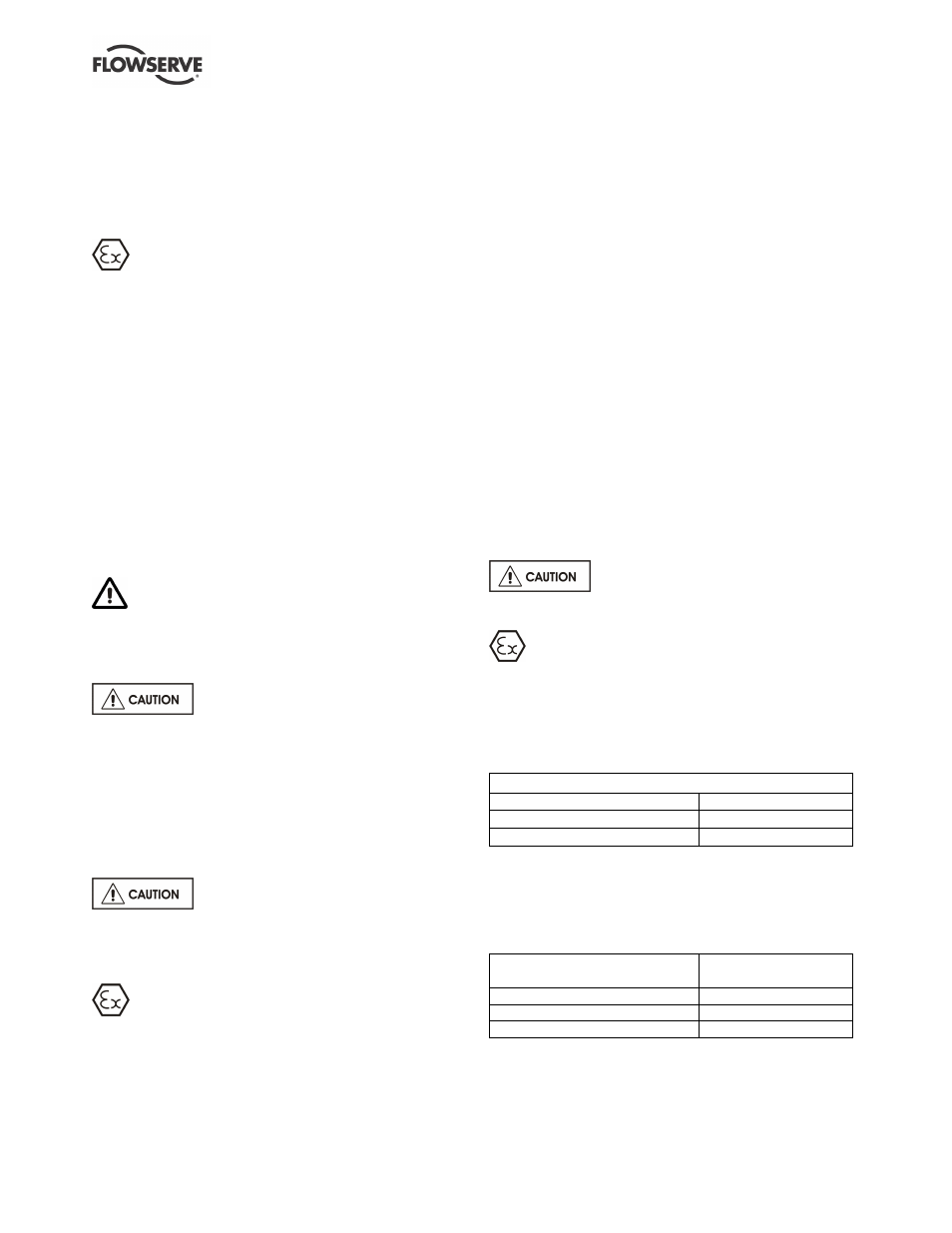8 running the pump – Flowserve CPXV fitted with WW User Manual
Page 18

CPXV - WW/CW USER INSTRUCTIONS ENGLISH 85392698 10-09
Page 18 of 36
flowserve.com
5.8 Running the pump
5.8.1 Pumps fitted with packed gland
If the pump has a packed gland there must be some
leakage from the gland. Gland nuts should initially be
finger-tight only. Leakage should take place soon after
the stuffing box is pressurised.
The gland must be adjusted evenly to give visible
leakage and concentric alignment of the gland ring to
avoid excess temperature. If no leakage takes place the
packing will begin to overheat. If overheating takes place
the pump should be stopped and allowed to cool before
being re-started. When the pump is re-started, check to
ensure leakage is taking place at the packed gland. If hot
liquids are being pumped it may be necessary to
slacken the gland nuts to achieve leakage.
Grease lubricated packed gland units will be fitted
with packing greased on initial assembly. If no
grease leakage takes place the packing will overheat.
The pump should be run for 30 minutes with steady
leakage and the gland nuts tightened by 10 degrees at a
time until leakage is reduced to an acceptable level.
Bedding in of the packing may take another 30 minutes.
Care must be taken when adjusting the gland
on an operating pump. Safety gloves are essential.
Loose clothing must not be worn to avoid being
caught up by the pump shaft. Shaft guards must be
replaced after the gland adjustment is complete.
Never run gland packing dry, even for
a short time.
5.8.2 Pumps fitted with mechanical seals
Mechanical seals require no adjustment. Any slight
initial leakage will stop when the seal is run in.
Before pumping dirty liquids it is advisable, if
possible, to run the pump in using clean liquid to
safeguard the seal face.
External flush or quench should be
started before the pump is run and allowed to flow for a
period after the pump has stopped.
5.8.3 Bearings
If the pumps are working in a potentially
explosive atmosphere temperature or vibration
monitoring at the bearings is recommended.
If bearing temperatures are to be monitored it is
essential that a benchmark temperature is recorded
at the commissioning stage and after the bearing
temperature has stabilized.
•
Record the bearing temperature (t) and the
ambient temperature (ta)
•
Estimate the likely maximum ambient
temperature (tb)
•
Set the alarm at (t+tb-ta+5) ºC (t+tb-ta+10) ºF
and the trip at 100 ºC (212 ºF) for oil lubrication
and 105 ºC (220 ºF) for grease lubrication
It is important, particularly with grease lubrication, to
keep a check on bearing temperatures. After start up
the temperature rise should be gradual, reaching a
maximum after approximately 1.5 to 2 hours. This
temperature rise should then remain constant or
marginally reduce with time. (Refer to section 5.2.5
for further information.)
5.8.4 Normal vibration levels, alarm and trip
For guidance, pumps generally fall under a classification
for rigid support machines within the International
rotating machinery standards and the recommended
maximum levels below are based on those standards.
Alarm and trip values for installed pumps
should be based on the actual measurements (N) taken
on the pump in the fully commissioned as new condition.
Regular monitoring of the pump vibration is
recommended to show any deterioration in pump or
system operating conditions. The vibration is
measured adjacent to the pump thrust bearing.
For remote installations continuous monitoring and
automatic alert and shutdown is recommended.
Vibration velocity – unfiltered mm/sec (in./sec) r.m.s.
Normal N
≤
7.1 (0.28)
Alarm N x 1.25
≤
9.0 (0.35)
Shutdown trip N x 2.0
≤
14.2 (0.56)
5.8.5 Stop/start frequency
Pump sets are normally suitable for the number of
equally spaced stop/starts per hour shown in the
table below. Check capability of the driver and
control/starting system before commissioning.
Motor rating kW (hp)
Maximum stop/starts
per hour
Up to 15 (20)
15
Between 15 (20) and 90 (120)
10
Above 90 (120)
6
Where duty and standby pumps are installed it is
recommended that they are run alternately every week.
